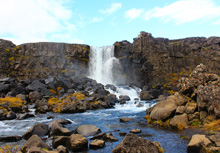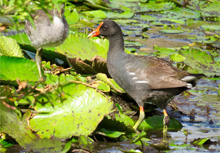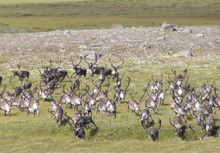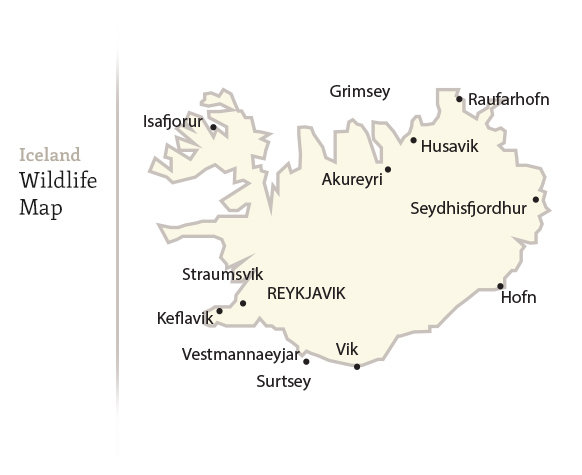Iceland is an island of active volcanoes in the Atlantic Ocean. Picturesque Iceland consists of mountain peaks, high glaciers, fjords, biggest waterfalls, black sand beaches, volcanoes, hot water geysers and fertile lowlands and lava fields. This beautiful setting is home to rich and abundant marine and birdlife. Wild mammals include the Polar Bear, Arctic Fox, mink, reindeer and many rodents, seabirds include Wildfowl like Myvatn, Barrow’s golden eye, great northern diver, Puffins, Skuas and kittiwakes. Seals, whales, dolphins and more than 300 species of fishes add to the marine life of Iceland. The Wildlifer recommends travel between May to mid July for birdwatching and whalewatching and December to March to spot Icelandic mammals and a chance to see Northern lights.
REACHING ICELAND
Reykjavik is the capital of Iceland and is well connected via Air and Ship. Iceland can be reached via various European and American destinations. Please see below connectivity and operation details of Icelandair.
All year: London, Glasgow, Copenhagen, Manchester, Oslo, Paris, Stockholm, Amsterdam, Frankfurt, Boston, New York and Seattle.
Seasonal: Denver Colorado, Edmonton, Halifax, Helsinki, Minneapolis / St. Paul, Orlando, Toronto, Trondheim, Vancouver, Washington DC and Zurich.
Summer: Alicante, Anchorage, Barcelona, Bergen, Berlin, Billund, Geneva, Madrid, Milan, Munich, Stavanger and St. Petersburg.
Other airlines include Finnair, SAS, Aeroflot, Norwegian, Flybe, Germanwings, Air Greenland, NIKI Luftfahrt, Thomas Cook Airlines, Easyjet, Greenland Express, WOW Air, Air Berlin, Austrian Airlines amongst other airlines that operate seasonally.
A regular Ferry called the Smyril Line also operates between Europe and Iceland.
The Wildlifer’s choice of Safari
Choose your Safari experience specially handpicked for the wildlifer.
-
Thingvellir National Park

A Unesco World Heritage Site and one of the stops of the Golden Circle( with Geysir Area and Gulfoss Waterfall) it is situated on the northern shore of Thingvallatn, the biggest lake of Iceland. Thingvallatn due to its clear waters and rich marine life is popular amongst anglers, snorkelers and scuba divers. The national park is famous for its volcanic and tectonic activities and hence continental drifts can be seen in various regions forming huge canyons in the area. Thingvellir which is just 50 kms from Reykjavik has the oldest existing parliament that met in AD930.
Area :
240 sq.km.
WILDLIFE :
The great northern driver is amongst the 52 bird species found here. A few migratory birds like the barrow’s golden eye and the harlequin duck can also be seen in the area. Foxes and minks can also be spotted around the lake Thingvallavatn. Several species of fish including the brown trout, Arctic charr and the three spine stickleback are found in the lake.
ACTIVITIES :
Hiking, Angling, Snorkelling and Scuba Diving.
-
Snaefellsjoekull National Park

This park was established on June 28th 2001 and has the famous Snaefellsjoekull glacier an active strotavolcano. This active volcano at 1446m was the setting of Jules Vernes’ famous Journey to the Center of the Earth. The park has some spectacular views with various lava formations and caves. The park touches the seashore and can be explored for both marine and coastal wildlife.
Area :
170 sq.km.
WILDLIFE :
Seabirds like the greater and lesser black back gulls, herring gull, glaucous gull, guillermots, kittiwake and fulmar dominate the area. Other birds found are the white wagtail, oystercatcher, purple sandpiper, golden plover, whimbrel, snow bunting and wheatear. Redwings are also found in the hollows of the lava. Migratory birds like the brent goose and knot can also be seen here. Foxes and Minks are easily spotted in the area. Marine mammals predominantly found are the cetaceans like the killer whales, minke whales and porpoises. The common and grey seals can sometimes be spotted from the coast. Crabs, shrimp, snails, fishes like the rock eels and several other sea creatures are also commonly found here.
ACTIVITIES :
Four wheel drive, snowmobile tours, Hiking, Birdwatching, whale watching.
-
Vatnajoekull National Park

Named after the Vatnajoekull glacier, the largest glacier in Europe, this is the most popular park in Iceland. A tectonic rift zone traverses the park and volcanic activities can be found in and around the glacier. This co-existence of ice and water is the reason for some mind boggling and unique volcanic and geomorphological formations. This unique combination of white glaciers, black sands, blue mountain lakes, green forests and multicoloured geothermal areas are home to various animal, bird and marine life.
Area :
14200 sq.km.
WILDLIFE :
Herds of Reindeer and pink footed geese, besides arctic foxes and minks can be found here. Seals and whales can also be spotted from the shore. Thousands of migratory birds and fishes inhabit the area during the summer.
ACTIVITIES :
Boat rides, glacier walks, ice cave tours and ice climbing, snowmobile tours, jeep tours on Vatnajo kull, ATV tours and geothermal baths at Hoffell, northern lights tours, reindeer excursions.


